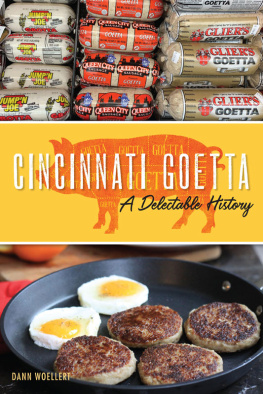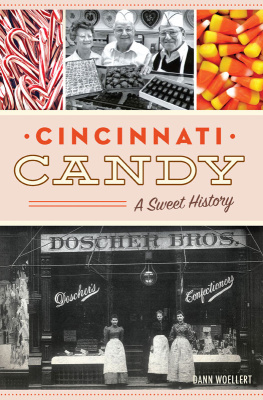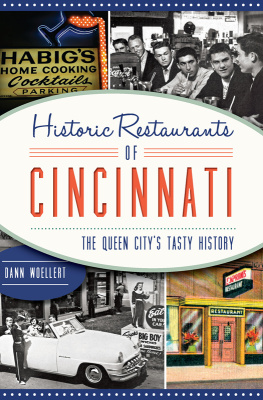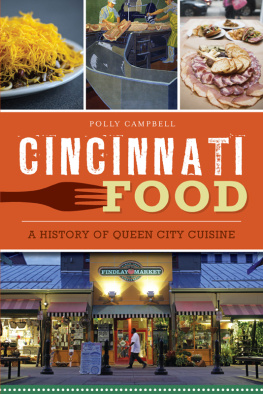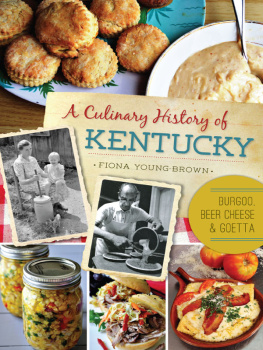


Published by American Palate
A Division of The History Press
Charleston, SC
www.historypress.com
Copyright 2019 by Dann Woellert
All rights reserved
Front cover, top: authors collection; bottom: courtesy of Mark Balasa, Queen City Sausage.
First published 2019
E-Book edition 2019
ISBN 978.1.43966.745.3
Library of Congress Control Number: 2019937037
Print edition ISBN 978.1.46714.208.3
Notice: The information in this book is true and complete to the best of our knowledge. It is offered without guarantee on the part of the author or The History Press. The author and The History Press disclaim all liability in connection with the use of this book.
All rights reserved. No part of this book may be reproduced or transmitted in any form whatsoever without prior written permission from the publisher except in the case of brief quotations embodied in critical articles and reviews.
To Owen, Jackson and Aidan, the next generation of goetta eaters and makers.
CONTENTS
Introduction
THE BIG GOETTA PROJECT
Cincinnati has a love affair with goetta. Its no secret. The top ten commerical producers of goetta in greater Cincinnati make an estimated two and a quarter million pounds of it annually. A true Cincinnatian has one or more of the following cooking utensils: a wort paddle to make beer, an oval plate to serve Cincinnati chili or a giant wooden paddle to stir goetta. After the question Vas you efer in Zinzinnati, the second question is, Hast du ever tasted Zinzinnati goetta? Its truly amazing that an obscure winter peasant breakfast food has made it front and center of our regional pop culture.
Mention goetta anywhere outside of a fifty-mile radius of Cincinnati, and youll get funny looks. But ask anyone inside that loop, and youll get a TED Talk on whose is best, how best to prepare it and what condiments should be used to dress it. For those in greater Cincinnati, goetta is a lifestyle. Its the topic of tall tales and legends. There are T-shirts with goetta sayings and two Goettafests a year. But you can find goetta year-round. Locals know at least one of more than one hundred restaurants that serve goetta in its purest form or concocted into an innovative fusion dish. Most have a favorite local butcher, if theyre not satisfied with the several commercial brands available at Kroger and big-box retailers. Although most like it fried crispy, the crispy vs. mushy debate has sparked family civil wars across the region. And dont even get started with what to dress it with. That conversation could last for hours.
The hardest thing is describing goetta to outsiders. My oldest friend from grade-school days, Mike, who prefers to dress his goetta with Franks hot sauce, describes the origin of goetta as if Scottish haggis and a German sausage got together and produced a really tasty baby. His family comes from at least a four-generation goetta-eating family. Ive heard others describe it as scrapples tastier cousin. I like that description a lot. In food writing, goetta is always the Jan Brady to scrapples Marcia. Goetta hasnt reached national status, yet. Online Scrabble doesnt recognize goetta as a word. And my iPhone is constantly autocorrecting my texts using goetta. Alexa responds that she doesnt know what goetta is made of. But then again, she was made in China. Siri does know about goetta, so thats encouraging.
I have relatives who no longer live in Cincinnati who say that whenever someone mentions goetta in a conversation, its like finding a long-lost relative that they even know that goetta exists. This is also the branch of my family who boasts that theyve never eaten commercially produced goetta, only homemade.
Long before there was Cincinnati chili, cheese coneys and Graeters raspberry chip ice cream, there was goetta. Immigrants from northwestern Germany brought the legacy with them over a century ago to remind them of home. Only in the last fifty years has it been more than an obscure cold-weather breakfast food. Its reached the tipping point of cultural hipness.
Since 2013, the Cincinnati Food and Wine Classic has sponsored an event called Goetta Superstar. It positions three groups of chefs against one another in a live version of Chopped. The teams must use goetta and another secret ingredient to make a cohesive dish. One year, it was goetta and paw paws.
Goetta is mentioned in a song by local bluegrass band Jake Speed & the Freddies, Queen City Christmas: Queen City Eggnog tastes much betta, when you add a pound of goetta.
Andrew Zimmern tasted goetta at the Six Acres Bed and Breakfast in College Hill in a recent episode of Bizarre Foods. Episode seven of season twelve, titled The Underground Railroad, connected goetta to the many Cincinnati Germans involved in the Underground Railroad and the abolitionist movement. It may have been fed locally to fugitive slaves, like the Cincinnati 28, a group that journeyed through the creek bed behind the B&B. Six Acres was built in the 1850s by Zebulon Strong, a Quaker abolitionist who helped escaping slaves.
The interesting thing about connecting goetta and fugitive slaves is that goetta is a lot like slave cooking. Goetta is based on taking lesser-quality cuts of meat and extending them with a grain. And thats exactly what slaves would do in their cooking. They were given the discarded cuts of meat from the wealthy masters and extend them with cooked greens or with a variety of beans. In Germany, the field workers, or heurling, on the large manors of German nobility were given the offcuts of meat from the owners of the manor and created the multitude of grain sausages or gruetzwurst, that birthed our goetta. How interesting would it be to find documentation that these slaves who escaped through Cincinnati had been fed goetta by German immigrant abolititionists, saw the similarity to their cooking and used goetta in their diets in the free communities where they settled in Canada?
Christmas is the busiest season for goetta. Most butchers and commercial producers say they make twice their normal amount during the winter holidays. Serving food is how we show people we love them. And for greater Cincinnatians, serving homemade or even store-bought goetta for breakfast over the holidays to our visiting relatives is the epitome of familial love. In fact, if visiting relatives arent served goetta at a family holiday brunch, they might ask, Does my family not love me anymore?!
Celebrities and public figures have chimed in about goetta. It had reached such national exposure that President George W. Bush asked in 2006, What is goetta?
In a 1979 interview with Bill Moyers, Ronald Reagan said this: We lived in a small town (Dixon, Illinois). It was from payday to payday with us, and I can remember one dish that I thought was delicious and it was only later that I realized why we had it. Have you ever heard of oatmeal meat? Well, you make oatmeal and you mix ground meat with it. Then you make a gravy just out of that, and then you serve that in a big pancake-like thing. Well, that was because we couldnt afford to have that pancake made of all meat. What President Reagan was referring to was hafer grits, or gritzwurst, a cousin to goetta that was common in the rural German immigrant communities of the Midwest.
Next page
